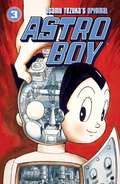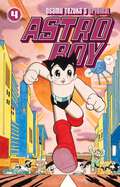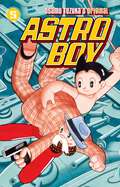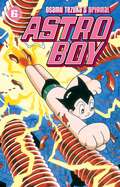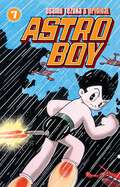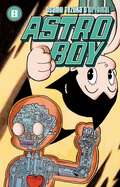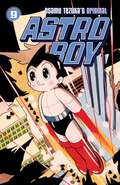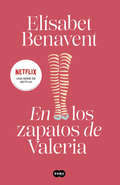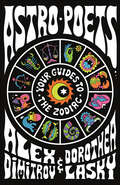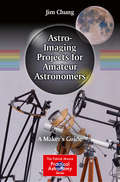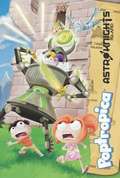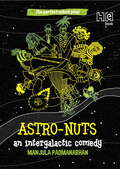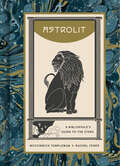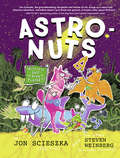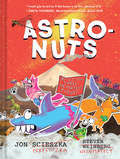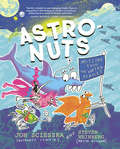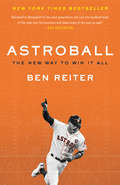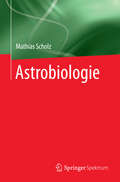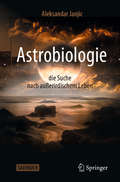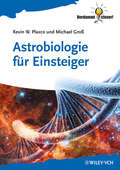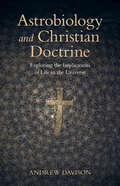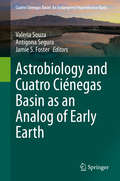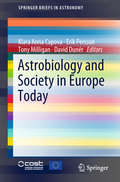- Table View
- List View
Astro Boy Volume 3 (Astro Boy)
by Osamu TezukaA timeless comics and animation classic, Osamu Tezuka' Astro Boy is still going strong nearly half a century after its creation, and Dark Horse brings Tekuza's original Astro Boy manga to America for the first time in an English-language edition. In the novel-length "The Greatest Robot on Earth," a wealthy sultan creates a giant robot to become the ruler of all other robots on Earth. But in order for that to happen, he must defeat the seven most powerful robots in the world, including Astro Boy, who must have his horsepower raised from 100,000 to 1,000,000 to face the challenge! And his sister, Uran, also flies in to lend a helping hand! Plus, in "Mad Machine," Professor Fuller invents a device that causes other machines to go berserk, and Astro Boy has to save the day!This volume contains the following stories:The Greatest Robot on EarthMad Machine
Astro Boy Volume 4 (Astro Boy #4)
by Osamu TezukaStanding shoulder to shoulder with comics and animation icons Krazy Kat, Mickey Mouse, and Tin Tin, Osama Tezuka's Astro Boy remains as fresh today as when the boy robot first appeared nearly fifty years ago. And Tezuka's Astro Boy original manga are now finally available in America in an English-language edition, produced in collaboration with Studio Proteus and translated by Frederik L. Schodt, well-known to manga readers for his work on Ghost in the Shell. In this volume: Astro fights to free abused robots from a robot theme park that masks a secret weapons factory; Astro and fellow robots are stranded on the moon only to discover a valley full of diamonds...but they are not alone, and the diamonds are not unguarded; Astro becomes trapped in the twentieth century after a child prodigy's time machine breaks down; and Professor Ochanomizu and Astro Boy are caught up in a movement to overthrow a dictator who has a machine capable of producing human clones...and a force of evil robots to defend it!This volume contains the following stories: Robot Land Ivan the Fool A Day to Remember Ghost Manufacturing Machine
Astro Boy Volume 5 (Astro Boy #5)
by Osamu TezukaHalf a century old, Astro Boy has once again taken America by storm! Created by the late, great Osamu Tezuka, Japan's "God of Manga," Astro Boy is the cornerstone of today's thriving manga and anime industries. Never before available in an English-language edition in the States, Dark Horse brings Astro Boy to America in collaboration with Studio Proteus, with translations by Frederik L. Schodt, author of Manga! Manga! and translator of Ghost in the Shell and Barefoot Gen. In this volume: Astro Boy must convince a confused robot not to aid an evil plot to take over an island rich in mineral wealth; a space leopard sent by conqueror aliens must be stopped before he can drain Earth's energy; and Astro must team with a robot-hating detective to apprehend thieves who have stolen an artificial sun!This volume contains the following stories: Crucifix Island Space Snow Leapord The Artificial Sun
Astro Boy Volume 6 (Astro Boy)
by Osamu TezukaIn the wake of the critical acclaim of the incredible Metropolis animated feature, interest in the work of Osamu Tezuka, creator of Metropolis and the godfather of Japanese comics and animation, has never been greater, and Astro Boy is the flame that ignited the modern manga and anime industries. Perhaps the most endearing, and enduring, character to emerge from Tezuka's volcanic imagination, Astro Boy thrills, amuses, and warms the hearts of readers of all ages. In this volume, a collision with an alien spacecraft sends Astro and the craft's female pilot fifty years into Earth's past, a past before robots -- not to mention aliens! Astro must find a way back to his present -- our future -- before he runs out of power, but his power is desperately needed in a world torn by war and the terror of nuclear weapons!
Astro Boy Volume 7 (Astro Boy)
by Osamu TezukaFrom the infinite imagination of the revered Osama Tezuka, creator of Metropolis, comes Astro Boy, the launching pad for the worldwide phenoma that are manga and anime. Standing among the pantheon of classic comics series, Astro Boy shows the absolute excitement, wonder, and entertainment that only the greatest comics can achieve, as only the true masters of the medium can create. In this volume, Astro Boy's adventures in the 20th Century continue. After lying buried beneath the Mekong river during the Vietnam War, Astro is discovered and revived many years later in a time when robots are worked like slaves and discarded like broken toys. Teaming with the young and idealistic Dr. Ochanimizu, Astro fights for robot rights...and encounters his creator, Dr. Tenma, at the time of Astro's creation, a situation that could create a dangerous time paradox!
Astro Boy Volume 8 (Astro Boy)
by Osamu TezukaOsamu Tezuka's Astro Boy has for fifty years represented the best in all-ages graphic fiction and is regarded universally as the launching pad for the worldwide manga and anime explosion. Filled with humor, action, drama, and humanity -- not to mention robots! -- Astro Boy will remind you why comics first grabbed your heart and imagination. In this volume, Astro remains stranded in the 20th century, but he's certainly not laying about! Astro must save the Earth from a voracious Martian fungus -- and save the intelligent organism from the hydrogen bomb -- all the while having to begin the fight for robot's rights and to keep robots from fighting each other!
Astro Boy Volume 9
by Osamu TezukaOsama Tezuka's Astro Boy is the all-time, 100,000 horsepower champion of classic all-ages robot action! Available for the first time in America, these tales are as exciting, touching, and hilarious as when Tezuka crafted them almost half a century ago! In this volume: Astro Boy tries to foil a mad scientist's plot to use a robotic Cleopatra to recreate the ancient kingdom of Egypt; Astro tries to solve the mystery of a young ghost appearing on 3D TVs; and Astro joins with the robot Cobalt in a race against time to stop a lost H-Bomb from devastating Japan!
Astro Poets: Tu guía del Zodiaco
by Dorothea Lasky Alex DimitrovEl primer gran manual de astrología del siglo XXI es divertido y útil, está salpicado de versos, contiene un mundo para cada signo y ¡llega de la mano del fenómeno Astro Poets! Si alguna vez te has preguntado por qué tu amiga géminis no te deja mediar palabra cuando salís a tomar algo, cuándo el «¿Sigues despierto?» que te escribe esa escorpio a las dos de mañana se convertirá en algo más (spoiler: no va a pasar), o cómo es que tu novio cáncer se deshace en lágrimas con los anuncios de pañales, estás en el lugar adecuado. En estas páginas llenas de grandes dosis de información, consejos, humor, lirismo y poesía, los Astro Poets te ayudarán a leer lo que han escrito las estrellas sobre ti para que lo uses a la hora de lidiar con tus amistades, tu carrera y tu complicada (¡o no!) vida amorosa. La crítica ha dicho...«Los Astro Poets iluminan internet.»The New York Times «Una guía deastrología como no has visto otra igual.»Bustle «Dimitrov y Lasky saben de lo que hablan y tienen un don para hacer que el etéreo mundo de la astrología parezca claro y cercano.»Vogue «Los lectores que quieran saber más sobre su signo quedarán encantados con este espléndido manual.»Publishers Weekly «Ha surgido una nueva voz popular en el firmamento del horóscopo, y tiene algo de la sensibilidad de Piscis y de la férrea autoestima de Leo, y es ingeniosa y amorosa.»Elle «El mapa astrológico definitivo... Un curso intensivo perfecto para principiantes, a la vez lírico, ingenioso y con el conocimiento suficiente para cautivar incluso a los ya iniciados.»Booklist «Una guía de signos divertida, accesible y supermoderna. Ricemos el rizo, ¡es astrología escrita por poetas! Si alguna vez te has preguntado qué dice tu horóscopo de ti (o cómo puede ayudarte a entender a los que te rodean), deberías empezar por aquí.»BookRiot
Astro Poets: Your Guides to the Zodiac
by Dorothea Lasky Alex DimitrovFrom the online phenomenons the Astro Poets comes the first great astrology primer of the 21st century. Full of insight, advice and humor for every sign in the zodiac, the Astro Poets' unique brand of astrological flavor has made them Twitter sensations. Their long-awaited first book is in the grand tradition of Linda Goodman's Sun Signs, but made for the world we live in today. In these pages the Astro Poets help you see what's written in the stars and use it to navigate your friendships, your career, and your very complicated love life. If you've ever wondered why your Gemini friend won't let you get a word in edge-wise at drinks, you've come to the right place. When will that Scorpio texting "u up?" at 2AM finally take the next step in your relationship? (Hint: they won't). Both the perfect introduction to the twelve signs for the astrological novice, and a resource to return to for those who already know why their Cancer boyfriend cries during commercials but need help with their new whacky Libra boss, this is the astrology book must-have for the twenty-first century and beyond.
Astro-Avian Apocalypse
by Peter HusseyProbably as soon as our great ancestors could put faces on their fears and notice the patterns of decay, destruction, and death throughout nature, they cobbled together tales of woe. Prophets had foretold various doomsday scenarios--all the extent of some god's righteous wrath. As it turned out, doomsday fell on a Saturday, 27th of June, 2076 AD, when two immense saucers 'blinked' into existence over Earth's polar caps and began a reign of unimaginable destruction. All attempts to communicate were futile, as were any efforts to thwart them while they continued their devastation, unabated. Were these two colossal discs the devices of God's will or were they from another world? Who was behind this 'stellar-assured' destruction and what would be the fate of humankind and its world when it ended? Only within these pages lie the answers.
Astro-Imaging Projects for Amateur Astronomers: A Maker’s Guide (The Patrick Moore Practical Astronomy Series)
by Jim ChungThis is the must-have guide for all amateur astronomers who double as makers, doers, tinkerers, problem-solvers, and inventors. In a world where an amateur astronomy habit can easily run into the many thousands of dollars, it is still possible for practitioners to get high-quality results and equipment on a budget by utilizing DIY techniques. Surprisingly, it's not that hard to modify existing equipment to get new and improved usability from older or outdated technology, creating an end result that can outshine the pricey higher-end tools. All it takes is some elbow grease, a creative and open mind and the help of Chung's hard-won knowledge on building and modifying telescopes and cameras. With this book, it is possible for readers to improve their craft, making their equipment more user friendly. The tools are at hand, and the advice on how to do it is here. Readers will discover a comprehensive presentation of astronomical projects that any amateur on any budget can replicate - projects that utilize leading edge technology and techniques sure to invigorate the experts and elevate the less experienced. As the "maker" community continues to expand, it has wonderful things to offer amateur astronomers with a willingness to get their hands dirty. Tweaking observing and imaging equipment so that it serves a custom purpose can take your observing options to the next level, while being fun to boot.
Astro-Knights Island (Poptropica)
by Tracey West Madpark Design Inc.When the princess of the kingdom of Arturus is kidnapped and taken into space by an evil inventor named Mordred, Simon and Alice must learn to build their own spacecraft and travel the stars to rescue the princess.
Astro-Nuts: An Intergalactic Drama
by Manjula PadmanabhanIt?s the General Assembly of the Galactic Union, and the first delegation from SOL-3 is desperate to present its case before it. The crazily assorted contingent of the third planet of the star SOL-aka Earth - carries with it all its baggage of opposing opinions, narrow views, squabbles, secrets and conspiracies. Toilets, whales, racism, food, body size...everything is cause for shouting matches and name-calling as the representatives ? 11 human and six non-human ? each wait to hold forth. To their shock and horror, they come to know that only one delegate will appear before the Assembly. Fuss and fireworks erupt among the elected leaders of the delegation, while five rebels plot a blow-up of a different kind. Uncertainty rules: Who is that one chosen speaker going to be and what is he, she or it going to say? Will SOL-3 be stuck with being `ecologically unfit for full membership to the Union?, or be seen as having `potential for change?? Is this interplanetary jamboree an insult, an opportunity, or a test? Among telepathic cookies and high-tech waste disposal, Manjula Padmanabhan sets up a colourfully cast, witty and thought-provoking stage spectacle sure to leave its audience and readers amused, inspired and applauding.
AstroLit: A Bibliophile's Guide to the Stars
by Rachel Feder McCormick TemplemanA unique, illustrated introduction to astrology that explores the zodiac through a literary lens, drawing lessons from celebrated authors including Jane Austen, Charlotte Brontë, W.E.B. Du Bois, Nella Larsen, Oscar Wilde, and dozens more.AstroLit is a cosmic voyage through the lives and works of literary giants from the eighteenth, nineteenth, and early twentieth centuries. Renowned literary history scholars McCormick Templeman and Rachel Feder bring the twelve signs of the zodiac to glimmering life by analyzing the astrological influence of over fifty illustrious writers' sun signs on the shape and depth of their work.Each of the twelve sections focuses on a particular zodiac sign, featuring profiles of three celebrated authors, analyzing their works and lives through the prism of their astrological sign. You'll uncover connections between writers' signs and their realms of creative influence, including the Capricornian ambition of Edgar Allan Poe and Zora Neale Hurston, the Sagittarian influence on William Blake's The Marriage of Heaven and Hell, and the Taurean gothiness evident in Mary Wollstonecraft's work. Each chapter also includes writing advice and reading recommendations for readers, no matter your sign.A delight for both astrology and book lovers, AstroLit is a gratifying exploration of classic literature and a playful way for readers and astrology lovers to learn something new about their favorite authors.
AstroNuts Mission One: The Plant Planet (AstroNuts #1)
by Jon ScieszkaThis laugh-out-loud, visually groundbreaking read launches a major new series by children's literature legend Jon Scieszka. Featuring full-color illustrations throughout, a spectacular gatefold, plus how-to-draw pages in the back, it's an outer space adventure that demonstrates a giant leap for bookmaking and a giant leap for any kid looking for their next go-to series. AstroWolf, LaserShark, SmartHawk, and StinkBug are animals that have been hybridized to find other planets for humans to live on once we've ruined Earth. So off they rocket to the Plant Planet! Will that planet support human life? Or do Plant Planet's inhabitants have a more sinister plan? AstroNuts Mission One is a can't-put-it-down page-turner for reluctant readers and fans ready to blast past Wimpy Kid.
AstroNuts Mission Three: The Perfect Planet
by Jon ScieszkaThis series is The Hitchhiker's Guide to the Galaxy meets The Bad Guys in a funny, visually daring adventure series for reluctant readers, teachers, and librarians alike.This hilarious, visually groundbreaking read is the conclusion to a major series by children's literature legend Jon Scieszka.The book follows a final mission, where AlphaWolf, LaserShark, SmartHawk, and StinkBug must find a planet fit for human life after we've finally made Earth unlivable.Time is up for our friends the AstroNuts. In fact, time is up for you, too. If they don't succeed on this mission, Earth is doomed! So when the team finds out they're being sent to a place called "the perfect planet," their mission sounds way too easy. Unfortunately, the second they land, they realize they'll be dealing with the most dangerous species of all time . . . humans. Huh? Where in the universe is this supposedly perfect place? And how will the Nuts manage to convince the humans to risk death . . . for the sake of their lives?!Featuring full-color illustrations throughout, Planet Earth as the narrator, an out-of-this-world gatefold, and how-to-draw pages in the back, eager and reluctant readers alike will be over the moon about this new mission. Full of laugh-out-loud humor with a thoughtful commentary on the reality of climate change at the core of the story, this creatively illustrated, full-color, action-packed space saga is a can't-put-it-down page-turner for readers of all levels and fans ready to blast past Dogman.EXCITING BIG-NAME TALENT: Jon Scieszka is one of the biggest names in children's books. The first National Ambassador of Young People's literature, he and Steven Weinberg toured extensively for this series. They'll continue making their way around the world for Book 3! You might have met them at ALA, the National Book Festival, the Rabbit HOle, the Brooklyn Book Festival, the Illinois Reading Council, the Tween Reads Book Festival, the Texas Book Festival, the NYC Department of Education Fall Conference, the 826 Story Soirée in New York, or NCTE in Baltimore!POPULAR SERIES: MISSIONS 1 and 2 received starred reviews, amazing blurbs, and tons of industry love. MISSION 1 was an Amazon Best Book of the Year! Dav Pilkey, Jennifer Holm, LeUyen Pham, and Gene Luen Yang are all big fans—check out those blurbs!FUN AND SCIENTIFIC: The book incorporates STEM elements in a way that readers will find fun and entertaining, while teachers and librarians will find it clever and original.PERFECT FOR BUDDING GRETA THUNBERGS: This book successfully talks about the effect of climate change and impels its readers to take action, without feeling didactic or message-y at all.TIES TO REAL-WORLD ISSUES: Readers will recognize quite a few dilemmas the AstroNuts face from current events on Earth. Making connections between fiction and non-fiction is a big developmental milestone for young readers, and this book works as an effective allegory for our most dire contemporary concerns.RELUCTANT READER–FRIENDLY: The book is a great vehicle for reluctant readers, featuring cool topics and bright art, and relying on visual literacy and very few words.A CONSTELLATION OF TOPICS: Space, STEM, and talking animals: There's something here for every reader!LOLs FOR DAYS: The book is funny and will delight kids who love books like Wimpy Kid, The 39-Story Treehouse, Dog Man, and Captain Underpants. While it contains serious ideas, it's a quick, easy, and fun visual read.GROUNDBREAKING DESIGN: The hundreds of pages of full-color art are dynamic and engaging—and it doesn't look like anything else out there. Steven Weinberg bases his art on public domain pieces from the Smithsonian museum! Teachers turn to the books for this element of the art and use it in classrooms to talk about collage, idea sourcing, history, and art medium.PERFECT ART PROJECT: On the website, kids can download pages of the "original" art and use it to make their own hybrid animal collages.Perfect for:• Perfect for fans of Dog Man, Big Nate, Wimpy Kid, and Captain Underpants• Families who care about the environment•
AstroNuts Mission Two: The Water Planet (AstroNuts #2)
by Jon ScieszkaAstroNuts Mission Two: The Water Planet is the second book in the laugh-out-loud series by children's literature legend Jon Scieszka.The book follows a new mission, where AstroWolf, LaserShark, SmartHawk, and StinkBug must find a planet fit for human life after we've finally made Earth unlivable. After they splash-land on the Water Planet, they find power-hungry clams, a rebellious underwater force, and a world full of too-good-to-be-true. Can this aquatic world really be humans' new home? And why are these clams so eager to swap planets?• A can't-put-it-down page-turner for reluctant readers• Complete with how-to-draw pages in the backAstroNuts Mission Two is full of laugh-out loud humor with a thoughtful commentary on the reality of climate change at the core of the story.Eager and reluctant readers alike ages 8 to 12 years old will be over the moon about this visually groundbreaking read. • Creatively illustrated, full-color action-packed space saga• Perfect for fans of Dog Man, Big Nate, Wimpy Kid, and Captain Underpants• Great for parents, grandparents, teachers, librarians, and educators who are looking to introduce STEM and environmental topics to children• You'll love this book if you love books like The Bad Guys in Superbad by Aaron Blabey, The 104-Story Treehouse: Dental Dramas & Jokes Galore! by Andy Griffiths, and The Stinky Cheese Man and Other Fairly Stupid Tales by Jon Scieszka.
Astroball: The New Way to Win It All
by Ben ReiterWhen Sports Illustrated declared on the cover of a June 2014 issue that the Houston Astros would win the World Series in 2017, people thought Ben Reiter, the article’s author, was crazy. <P><P>The Astros were the worst baseball team in half a century, but they were more than just bad. They were an embarrassment, a club that didn’t even appear to be trying to win. The cover story, combined with the specificity of Reiter’s claim, met instant and nearly universal derision. <P><P>But three years later, the critics were proved improbably, astonishingly wrong. How had Reiter predicted it so accurately? And, more important, how had the Astros pulled off the impossible? <P><P>Astroball is the inside story of how a gang of outsiders went beyond the stats to find a new way to win—and not just in baseball. When new Astros general manager Jeff Luhnow and his top analyst, the former rocket scientist Sig Mejdal, arrived in Houston in 2011, they had already spent more than half a decade trying to understand how human instinct and expertise could be blended with hard numbers such as on-base percentage and strikeout rate to guide their decision-making. <P><P>In Houston, they had free rein to remake the club. No longer would scouts, with all their subjective, hard-to-quantify opinions, be forced into opposition with the stats guys. Instead, Luhnow and Sig wanted to correct for the biases inherent in human observation, and then roll their scouts’ critical thoughts into their process. The numbers had value—but so did the gut. <P><P>The strategy paid off brilliantly, and surprisingly quickly. It pointed the Astros toward key draft picks like Carlos Correa and Alex Bregman; offered a path for developing George Springer, José Altuve, and Dallas Keuchel; and showed them how veterans like Carlos Beltrán and Justin Verlander represented the last piece in the puzzle of fielding a championship team. <P><P>Sitting at the nexus of sports, business, and innovation—and written with years of access to the team’s stars and executives—Astroball is the story of the next wave of thinking in baseball and beyond, at once a remarkable underdog story and a fascinating look at the cutting edge of evaluating and optimizing human potential.
Astrobiological Neurosystems: Rise and Fall of Intelligent Life Forms in the Universe (Astronomers' Universe)
by Jerry L. CranfordThis book explains why scientists believe that life may be more common in the Universe than previously considered possible. It presents the tools and strategies astronomers and astrobiologists are using in their formal search for habitable exoplanets as well as more advanced forms of life in other parts of our galaxy. The author then summarizes what is currently known about how and where organic molecules critical to our form of carbon-based life are manufactured. The core of the book explains (and presents educated guesses) how nervous systems evolved on Earth, how they work, and how they might work on other worlds. Combining his knowledge of neuroscience, computers, and astrobiology the author jumps into the discussion whether biological nervous systems are just the first step in the rise of intelligence in the Universe. The book ends with a description from both the psychologist's and the neuroscientist's viewpoints, exactly what it is about the fields of astrobiology and astronomy that "boggles the minds" of many amateur astronomers and interested non-scientists. This book stands out from other popular science books on astrobiology by making the point that "astro-neurobiologists" need to begin thinking about how alien nervous systems might work.
Astrobiologie
by Mathias ScholzUnter welchen Bedingungen entsteht ,,Leben" und wie ist es im Kosmos verbreitet? Damit beschäftigt sich der Autor und stellt wichtige Facetten einer jungen Wissenschaftsdisziplin ausführlich vor: · Was ist und wie funktioniert ,,Leben"? · Entstehung des Lebens auf der Erde · Kosmische Voraussetzungen für ,,Leben, wie wir es kennen" · Leben im Sonnensystem und darüber hinaus · Suche nach außerirdischen Zivilisationen Zudem wird das spannende Gebiet der Astrochemie behandelt, welches erklärt wie sich die molekularen Grundbausteine des Lebens unter kosmischen Bedingungen bilden. Das Buch wendet sich an interessierte Studenten der Natur- und Ingenieurwissenschaften, Abiturienten, Dozenten, Lehrer und nicht zuletzt an Amateurastronomen.
Astrobiologie - die Suche nach außerirdischem Leben
by Aleksandar Janjic"Wie können wir in diesem Jahrhundert außeridisches Leben endgültig nachweisen? Sollte es Leben in unserem Sonnensystem geben, wird es in diesem Jahrhundert gefunden werden. Mit diesem Buch wird dem Leser der aktuellste Stand der Astrobiologie verständlich vermittelt und über die heutigen und anstehenden Missionen der Raumfahrtbehörden berichtet. Kommen Sie mit auf die Reise von der Entstehung des Lebens, über die Möglichkeiten von Leben in unserem Sonnensystem, bis hin zu Exoplaneten und fernen erdähnlichen Welten, um das Phänomen des Lebens als planetaren Prozess verstehen zu können.
Astrobiologie für Einsteiger (Verdammt clever!)
by Kevin W. Plaxco Michael GroßNach einem einführenden Kapitel über die Definition von Leben beginnt die Erkundung des Themas »Leben im Universum« mit der Geschichte des Universums, unter besonderer Berücksichtigung der Umstände, die die Entwicklung von Leben ermöglicht haben. Es fokussiert dann in ähnlicher Weise auf die Geschichte unseres Sonnensystems und der Erde. Im mittleren Teil des Buchs geht es um das Leben auf der Erde: wie konnte es entstehen, sich ausbreiten, und mehr als drei Milliarden Jahre lang überleben? Welche seiner Eigenschaften sind Zufall, und welche Notwendigkeit? Im letzten Drittel des Buchs werden die Erkenntnisse aus der irdischen Biologie angewandt auf die Suche nach Leben im übrigen Sonnensystem (Mars, Monde des Jupiter und Saturn) und nach lebensfreundlichen Planeten im Rest des Universums.
Astrobiology and Christian Doctrine: Exploring the Implications of Life in the Universe (Current Issues in Theology)
by Andrew DavisonIn recent decades, powerful telescopes have enabled astrophysicists to uncover startling new worlds and solar systems. An epochal moment came in 1995, when a planet – 51 Pegasi b – was located orbiting a star other than our own sun. Since then, thousands of new planets have followed, and the question of life beyond earth has become one of the principal topics in discussions between science and religion. Attention to this topic has a long history in Christian theology, but has rarely been pursued at any depth. Writing with both passion and precision, Andrew Davison brings his extensive knowledge of Christian thought to bear, drawing particularly on the thought of Thomas Aquinas, as well as his training as a scientist. No book to date better prepares the Christian community for responding to evidence of other life, if it is found. And yet, we do not need to wait for that to have happened before this book shows its worth. In thinking about planets, creatures, and ecosystems beyond our planet, Davison already reinvigorates our theology for the earth.
Astrobiology and Cuatro Ciénegas Basin as an Analog of Early Earth (Cuatro Ciénegas Basin: An Endangered Hyperdiverse Oasis)
by Valeria Souza Antígona Segura Jamie S. FosterAstrobiology not only investigates how early life took hold of our planet but also life on other planets – both in our Solar System and beyond – and their potential for habitability. The book take readers from the scars on planetary surfaces made by space rocks to the history of the Solar System narrated by those space rocks as well as exoplanets in other planetary systems. But the true question is how life arose here or elsewhere. Modern comparative genomics has revealed that Darwin was correct; a set of highly conserved genes and cellular functions indicate that all life is related by common ancestry. The Last Universal Common Ancestor or LUCA sits at the base of the Tree of Life. However, once that life took hold, it started to diversify and form complex microbial communities that are known as microbial mats and stromatolites. Due to their long evolutionary history and abundance on modern Earth, research on the biological, chemical and geological processes of stromatolite formation has provided important insights into the field of astrobiology. Many of these microbialite-containing ecosystems have been used as models for astrobiology, and NASA mission analogs including Shark Bay, Pavilion and Kelly Lakes. Modern microbialites represent natural laboratories to study primordial ecosystems and provide proxies for how life could evolve on other planets. However, few viral metagenomic studies (i.e., viromes) have been conducted in microbialites, which are not only an important part of the community but also mirror its biodiversity.This book focuses on particularly interesting sites such as Andean lake microbialites, a proxy of early life since they are characterized by very high UV light, while Alchichica and Bacalar lakes are characterized by high-salt and oligotrophic waters that nurture stromatolites. However, it is only the oasis of Cuatro Ciénegas Basin in México that stored past life in its marine sediments of the Sierra de San Marcos. This particular Sierra has a magmatic pouch that moves the deep aquifer to the surface in a cycle of sun drenched life and back to the depths of the magmatic life in an ancient cycle that now is broken by the overexploitation of the surface water as well as the deep aquifer in order to irrigate alfalfa in the desert. The anthropocene, the era of human folly, is killing this unique time machine and with it the memory of the planet.
Astrobiology and Society in Europe Today (SpringerBriefs in Astronomy)
by Tony Milligan David Dunér Klara Anna Capova Erik PerssonThis White Paper describes the state of astrobiology in Europe today and its relation to the European society at large. With contributions from authors in twenty countries and over thirty scientific institutions worldwide, the document illustrates the societal implications of astrobiology and the positive contribution that astrobiology can make to European society. The White paper has two main objectives: 1. It recommends the establishment of a European Astrobiology Institute (EAI) as an answer to a series of challenges relating to astrobiology but also European research, education and the society at large. 2. It also acknowledges the societal implications of astrobiology, and thus the role of the social sciences and humanities in optimizing the positive contribution that astrobiology can make to the lives of the people of Europe and the challenges they face.This book is recommended reading for science policy makers, the interested public, and the astrobiology community.
